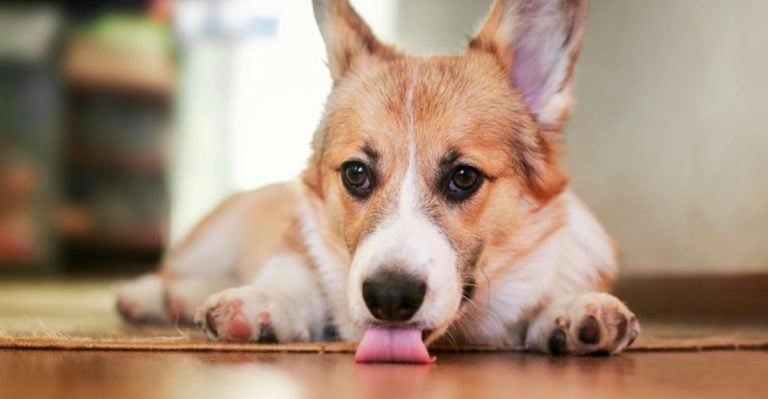How Overweight Dogs Show Their Struggles (With Tips To Manage)

Have you ever noticed your pup slowing down or skipping playtime? Small changes in behavior can be easy to ignore, but they might be telling you something important. As dogs age or their routines shift, their bodies can change fast. Here’s how to recognize the signs and help them stay healthier.
Trouble Feeling The Rib Cage

A healthy dog’s ribs should feel like the back of your hand and can be easily found beneath a thin layer of muscle and skin. If you must press through a cushiony layer of fat, your dog likely weighs too much. This standard applies across breeds, though deeper-chested dogs like Boxers or Greyhounds may show ribs more naturally.
No Visible Waistline Shape

When you look down from above, your dog should have a slight hourglass figure behind the ribs. The tuck-up where the belly rises behind the ribcage should be visible from the side, too. If the waist blends into the hips without a dip, your dog’s body condition score is likely in the overweight or obese range.
Difficulty Walking Or Running

Excess weight strains joints and soft tissues, especially in the hips, knees, and spine. Breeds like German Shepherds, Labs, and Dachshunds are more vulnerable to discomfort when overweight. You may notice slower movement or reluctance to jump, and obesity can even lead to serious issues like cruciate ligament tears.
Breathing Heavily After Light Activity

Heaving breaths after a short stroll? That’s a red flag. Overweight dogs often develop restricted airways and reduced lung capacity. In brachycephalic breeds like Bulldogs or Shih Tzus, fat in the throat and chest can worsen existing breathing issues. Even non-flat-faced dogs will pant more as fat compresses their diaphragm.
Reluctance To Play

Energy levels are tied directly to physical comfort. A healthy dog craves movement: chasing balls, greeting guests, or romping around the yard. But when weight puts stress on the joints, that enthusiasm fades fast. It’s especially true for herding and sporting breeds that are wired for activity.
Fat Pads Around The Body

Fat doesn’t accumulate evenly. It tends to cluster around the neck, over the spine, behind the shoulders, or near the tail base. These are called “fat pads,” and they often show up before the scale tips noticeably. In Labradors and Golden Retrievers, you might spot soft bulges over the ribcage.
No Energy Between Meals

A dog that eats, sleeps, and repeats may not be getting lazy; they might be metabolically sluggish. Extra weight slows down endocrine function and makes each movement feel heavier. You’ll see this most in senior dogs, but even younger pups can show signs of fatigue after moderate meals.
Clothes Or Gear No Longer Fit

If your dog’s harness now leaves marks or needs adjusting every week, don’t assume it’s shrinking. Adjustable harnesses suddenly sit higher than usual or require looser settings. Even GPS collars with snug fits might begin to chafe.
Noticing the signs is only half the battle. Now, it’s time to take action. These next tips can help your dog shed the extra fluff safely and without skipping the treats entirely.
Switch To Measured Meal Portions

A dog that needs 1.5 cups a day might be eating 2.5 cups without you realizing it. Use a standard measuring cup and stick to your vet’s recommendations. Consider calorie density, too, as some foods pack 500 calories per cup, while others only contain 300.
Add More Daily Exercise

The magic number is consistency. Even 15 to 30 minutes of walking twice a day can boost your dog’s metabolism. Indoor games like tug-of-war or hide-and-seek work well for smaller breeds or seniors. Active breeds like Huskies or Border Collies may need more structured movement.
Use Treats With Lower Calories

Store-bought treats usually contain as many calories as a small meal. Opt for air-dried proteins, dental chews under 20 calories, or crunchy produce like green beans, cucumber slices, or apple bits (no seeds). Always subtract treat calories from their total daily intake. Better yet, use part of their kibble as a reward.
Choose Weight Management Dog Food

Weight-control formulas reduce fat and increase fiber to help dogs feel full without extra calories. Many include L-carnitine, a supplement that helps the body burn fat more efficiently. Check the label for caloric density and the first few ingredients; avoid fillers like cornmeal or meat by-products.
Limit Human Food And Scraps

That single French fry is 10% of a small dog’s daily calories. Most table food is high in salt or spice, none of which a dog’s digestive system handles well. Rich foods can cause pancreatitis, especially in smaller breeds like Yorkies or Chihuahuas. Even lean meats can become problematic if seasoned or cooked in oils.
Track Progress With Regular Weigh-Ins

Monitoring weight every two to four weeks can catch trends before they become problems. Use the same scale for consistency, and always weigh at the same time of day. For dogs too large to lift, many pet stores offer self-serve scales. Track progress in a journal or app.
Talk To A Professional Trainer

Trainers can spot movement issues and help correct behavioral patterns that lead to weight gain, like constant begging or reward overfeeding. They’ll often create custom routines based on your dog’s energy level, age, and limitations. For example, overweight senior dogs might benefit from scent work, which exercises the mind and body.






